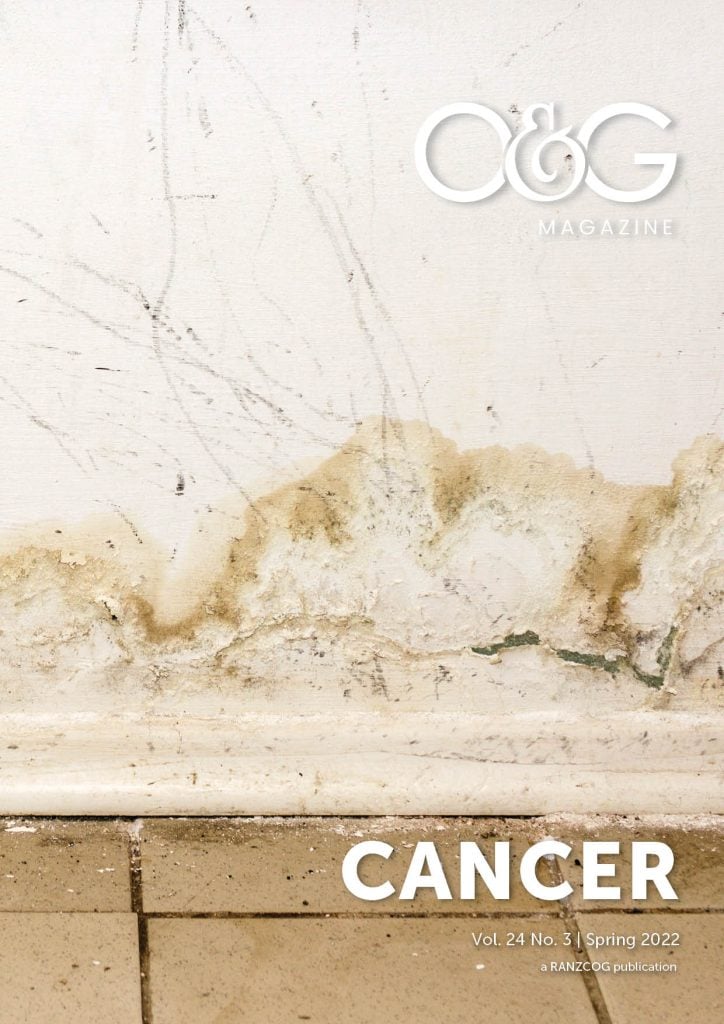Gynaecological cancers represent a large burden of disease for women and their carers in Australia and New Zealand. In 2017, with 5,823 new cases, they accounted for 9.3% of cancers diagnosed in women, with uterine cancers being the most common. By 2021 it was estimated that the risk of having a gynaecological cancer was 1 in 23 (4.4%) by the time a woman reaches 85 years of age.1 Globally, a cancer diagnosis will also be made in 1 in 2000 pregnancies with the majority of these being breast cancers and accordingly the need for consensus guidelines for pregnant women with cancer is increasingly recognised.
Tracking a parallel course with the obesity epidemic in the western world, the number of women receiving care for uterine cancer continues to rise. While the majority have early disease and will likely be cured with surgery, the survival rates for advanced disease are dismal so the recognition of molecularly distinct endometrial tumours that may benefit from target-based therapies going forward is showing exciting promise and indeed, at the same time, may save many others the toxicity associated with traditional adjuvant therapies such as radiotherapy and chemotherapy.
In contrast to the tsunami of uterine cancers, the number of cases of ovarian cancer (now recognised as including ovarian, fallopian tube and primary peritoneal cancers, OFP) appears to be falling and published mortality rates in Australia are showing a downward trend.2 The falling incidence has been linked to oral contraception usage over time which reduces ovarian cancer risk with increasing length of use up to ten years, as well as the recognition of at-risk women with genetic mutations with the opportunity to intervene at the appropriate time with risk reduction strategies such as bilateral salpingo-oophorectomy, acknowledging that there is no current recommendation for population screening or screening of any high-risk women. Whether salpingectomy alone proves to be a significant strategy to reduce risk remains to be seen and is being explored in a number of ongoing international studies. The advent and effectiveness of poly ADP-ribose polymerase inhibitors (PARPi) in women with OFP cancers with a BRCA mutation (somatic/germline) means that for the first time ever gynaecological oncology specialists are beginning to talk about ‘cure’ even in women with advanced disease at diagnosis.
While each gynaecological cancer may be considered as a unique disease and indeed by definition rare, as a group, gynaecological cancers represent the fourth most common cancer diagnosis in women and are most appropriately managed by the same multidisciplinary group of medical practitioners. This is particularly important with the implication of strategies set to eliminate cancers such as cervical cancer. Australia and New Zealand are considered world leaders in this regard with the success of the national HPV vaccination programs for primary prevention and robust screening programs for secondary prevention. Ongoing efforts will still be required in at-risk groups, Māori and Indigenous Australian women, for whom screening rates remain low. The latter is more reflective of the global burden of gynaecological cancer with cervical cancer being the most commonly diagnosed cancer and continuing to increase in incidence and be responsible worldwide for most gynaecological cancer deaths with the highest burden of disease in regions with a low sociodemographic index (SDI).3
Gynaecological cancer care is well established in Australia and New Zealand, and it is great that this issue is dedicated to cancer. It is by no means exhaustive in covering all aspects of cancer care but it provides many important updates as well as inspiring contributions from a consumer, a general practitioner involved in end-of-life care and a community project team providing local support in close collaboration with medical practitioners.
With ongoing advocacy and dedicated research, we as a medical profession can continue to strive to provide holistic care for women at risk of, and diagnosed with, gynaecological cancers and cancers in pregnancy.
References
- Australian Institute of Health and Welfare. Cancer in Australia 2021, AIHW, Australian Government. 2022.
- www.cancervic.org.au/downloads/cec/cancer-in-vic/Cancer-in-Victoria-statistics-and-trends-2020.pdf
- Yi M, Li T, Niu M, et al. Epidemiological trends of women’s cancers from 1990 to 2019 at the global, regional, and national levels: a population-based study. Biomark Res. 2021;9:55.







Leave a Reply